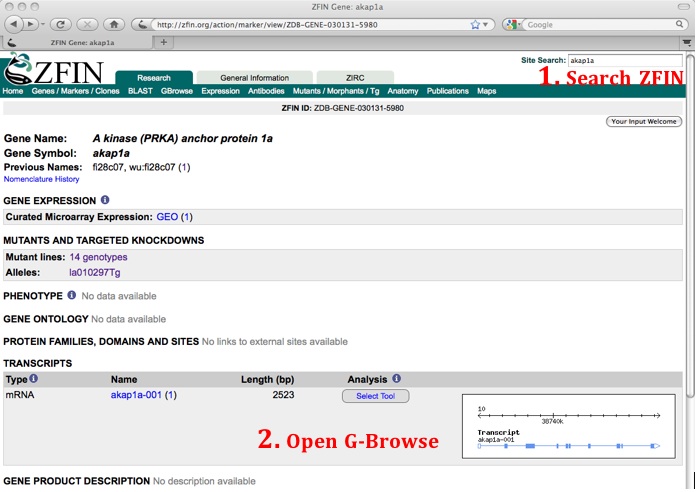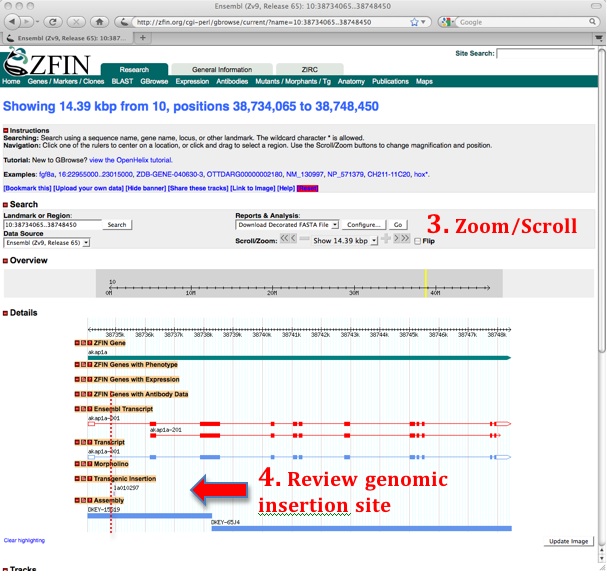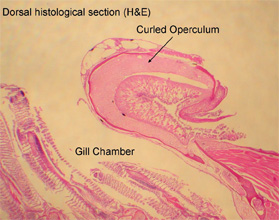| ZIRC Frequently Asked Questions |
Who should I contact with more specific questions, or if my question has not been fully answered on this FAQ page?
If you have any further questions in the following areas, feel free to contact the ZIRC staff any time with any questions, comments, or concerns. It is important to us to interact with you personally and if possible, provide specific help to you.
For general questions contact
Erin Quinn
Zoltan Varga
For questions about fish ordering and shipping contact
David Lains
For questions regarding ordering cDNA/ESTs or monoclonal Anibodies contact
Erin Quinn
For questions regarding submitting (a) fish line(s) contact
April Freeman
For questions regarding fish health, our pathology service, and to obtain the ZIRC fish health report contact
Katy Murray
For scientific questions regarding any of our resources contact
Zoltan Varga
Andrzej Nasiadka
For questions regarding our online ordering system and web presence contact
Ron Holland
For questions about water quality, shipping conditions, and our aquaculture system contact
David Lains
If you want to know about the status of a resource that is not yet listed online, but the discoverer/originator of the resource told you it has been submitted to the ZIRC, contact
April Freeman
top
How do I place an order for fish or embryos?
The Resource Center uses a "shopping cart" order system. You browse our lists of items for sale and add your choices to a shopping cart. When you have finished adding items to your cart, you go through a checkout process wherein ZIRC gathers your shipping, billing, and payment method information. At any point in the process you may add or delete items from your cart. At the end of the process your request is placed with us and you are sent a confirmation email. The ZIRC staff will contact you at a later date to confirm a shipping date for your fish.
Please Note: Fish or Embryo orders are always sent as soon as possible. International shipments are sent on Mondays via an international courier and domestic shipments are sent on Wednesdays via overnight courier. If an order is placed and the shipping date is confirmed by Thursday the order will ship the following Monday or Wednesday. If orders are received and confirmed after Thursday, then they will be shipped one week later.
Our searchable product lists are available through the ZIRC web site
(http://zebrafish.org/zirc/). You will need the following information: zebrafish line (strain) name and mutant allele (wild-types do not have allele designations).
To request a fish line, select the "Fish Lines" link in the "Request Products" area. You will be taken to a searchable list of zebrafish lines for sale. You may browse the list or search for a fish line using the line name, the allele, the gene symbol / locus abbreviation, or the ZIRC catalog number.
To add a fish line to your shopping cart, select the check box to the left of the line name and then click the "add selected to cart" button. You will be asked about your desired type (embryos and/or adults) and quantity. Click the "continue" button to add the fish line shown to your cart.
At the shopping cart page you may edit type and/or quantity for any item as well as remove any item.
When you are ready to complete your request, click the "Proceed to Checkout" button on the Shopping Cart page and you will complete the 5 easy steps to place your request.
How can I pay for my purchase?
ZIRC accepts purchase orders (PO), checks, credit cards and international bank transfers. You can find the appropriate instructions on our web site under Payment Information and you can specify how you want to pay for your request during the checkout procedure.
top
How do I submit a zebrafish line to ZIRC?
To begin the submission process, agree to the ZIRC Fish Line Submission Terms and Conditions (http://zebrafish.org/zirc/submissions/submitTerms.php) and then follow the subsequent submission instructions, filling in the Fish Line Submission Form spreadsheet as thoroughly as possible. After receiving the required information, your submission will be passed on to the ZIRC External Review Board. This process can take up to 6 weeks. During this time you may be contacted for additional information.
After the review process is complete, you will be notified of the External Review Board's decision. If your submission has been approved for importation to ZIRC, you will be given further instructions by a member of the ZIRC staff.
For detailed information about this process, please contact April Freeman.
top
Where can I find a list of zebrafish lines available at ZIRC?
A complete list of lines available at ZIRC can be found on our web site at http://zebrafish.org/zirc/fish/lineAll.php. Additionally, source information for mutant and transgenic lines can be found by
searching ZFIN for a specific allele by using the following steps:
1. Search by allele, abbreviation, or locus name.
2. Select the specific allele of interest.
3. "Zebrafish International Resource Center" will be listed under "Current Source" if available.
4. Click the "order this" link to see ZIRC availability for the line.
top
The ZIRC disclaimer tells me that not all putative mutants are equal. Exon hits and first intron hits are most likely to be mutagenic. How can I determine where in the genome a particular insertion is located?
1. Please search for your gene of interest on ZFIN and go to its gene page. For example: akap1a (ZFIN ID: ZDB-GENE-030131-5980).
2. In the Transcripts section, open the G-browse track.
3. Search the G-Browse info for the Transgenic Insertion to locate the specific insertion site. It is marked with the allele designation la010297. You may need to scroll or zoom the G-Browse track to locate the insertion.
4. Determine whether the allele you are considering is likely to distrupt gene function. Exon hits and first intron hits are the most likely to be mutagenic.


What zygosity should I expect to receive when placing an order for mutant embryos or adults?
Line Availability
ZIRC provides fish lines in 4 ways:
Embryos
Embryos are provided in quantities of 100. Zygosity is determined by the ZIRC staff based upon availability. This information will be provided with the shipped embryos.
Adults
Adults are provided as identified pairs of heterozygous carriers (one female and one male) ranging from 3 to 12 months of age.
Frozen
Lines stored as frozen sperm are regenerated by in vitro fertilization of AB eggs and shipped at the time of request. They are provided as 30 or more embryos. Special fees apply.
Frozen *
Frozen* lines are regenerated by in vitro fertilization of AB eggs and raised at ZIRC. Once carriers are identified, they are shipped as embryos or, if available, as identified pairs. This process takes a minimum of 6 months and special fees apply. Please note that in some cases, the submitting laboratory provided ZIRC with only a single sample of frozen sperm and there is a chance in vitro fertilization will not be successful.
top
What is the Zebrafish International Resource Center's tax identification number?
93-6001786W
top
How do I acclimate zebrafish to my system?
When your fish arrive, float them in aquarium water 10-15 minutes to equilibrate temperature. Once at temperature, open the bag and immediately pour the fish though a net, discarding the shipping water and introduce fish to new clean fish water. Do not mix the water as this can cause ammonia toxicity by diluting the ammonia binder and increasing the pH. Discard shipping/acclimation water.
Shipping is stressful on fish. Their circadian rhythm is disrupted and they have not fed in 24 hours. Please allow them at least 2 weeks of recuperation before breeding.
We package our fish with pure Oxygen and ClorAm-X, an ammonia binder.
top
How do I acclimate embryos upon arrival?
When the embryos arrive, check the temperature of the embryos and warm or cool them slowly to 28.5°C.
In addition, all embryos are bleached and briefly rinsed with a dilute pronase solution before leaving the ZIRC. A tough chorion can be a by-product of the bleaching procedure. If the embryos do not hatch on their own by 96 hpf, the chorions will need to be removed manually. The procedure for removing the chorions can be found in The Zebrafish Book or at http://zfin.org/zf_info/zfbook/chapt4/4.1.html.
We also recommend housing the embryos in E2 Solution until they have hatched and are swimming.
top
What female to male ratio do you use when breeding fish?
We breed our fish using a ratio of 2 females : 1 male.
top
What is the "blue stuff" in the embryo water?
We use methylene blue at 0.5 ppm in our embryo media to reduce the growth of bacteria or fungus in case any embryos die en route.
top
What water quality parameters does ZIRC maintain?
We maintain our water with the following parameters:
pH: 7.2 to 7.6
Conductivity: 500 µS
Temperature: 28º C
Ammonia: 0 ppm
Nitrite: 0 ppm
Nitrate: 0 ppm to 5 ppm
Exchange rate: 10% per day (Reverse Osmosis water)
Please feel free to contact us if you have any questions or concerns about your aquaculture system or water chemistry.
top
How do I prepare fish for histopathology?
For optimum results, fish must be alive and euthanized just prior to fixation. Autolysis occurs rapidly once a fish dies. This makes fish that are found dead poor specimens for histopathology. Fish should be fixed prior to shipment using the protocol below. Do not freeze fish and do not use aqueous formalin or paraformaldehyde fixatives. These fixatives yield poor histological results. Please prepare specimens as specified below.
Fixation Protocol for Histopathology Specimens
1.Prepare Dietrich's Fixative (100 ml) as follows. Store fixative at room temperature.
a. 30 ml ethanol
b. 10 ml formalin (Formaldehyde 37% solution containing 10-15% methanol, Sigma # F1635)
c. 2 ml glacial acetic acid
d. 58 ml distilled water
2.Euthanatize fish with an overdose of MS-222 (tricaine methane sulfonate).
3.Carefully slit open the body cavity along the belly, trying not to disrupt internal organs.
4.Use 10-15 ml of fixative per 1-2 fish in a sealable container. The volume of fixative should be at least 10 times the volume of the specimen.
5.Store and ship fixed fish in Dietrich's fixative. Fish can be stored for several weeks in Dietrich's fixative.
top
My fish seem to have damaged gill covers so the gills are visible. Is this normal?
Malformations of the operculum in zebrafish are fairly common. Operculums can be shortened or curl outward exposing the gills. The curling of operculums can be progressive and more pronounced in older fish. The causes of operculum malformations include genetic (very common in zebrafish with a Tübingen background), embryonic temperature shock, nutrition and possibly chemical agents. The inability to completely cover the gill cavity may impair a fishs ability to cope with situations of poor water quality and respiratory distress. Some photos of the condition in a TU adult are included below.


top
What are the quarantine recommendations for zebrafish?
Bringing new fish into a facility can also bring in new pathogens. The use of strict quarantine practices (i.e., introducing only surface sanitized embryos) can eliminate a large number of potential pathogens from entering a facility and is strongly recommended for all laboratory zebrafish colonies. When adult fish are acquired they are held in quarantine until they can successfully breed and only bleached embryos are introduced into the main facility or system. The ideal quarantine area is a room completely separated from the main fish facility on a flow-through water system. Small facilities often utilize individual aquariums or small recirculating systems in a designated quarantine area. Fish are observed and acclimated in quarantine for a minimum of two weeks prior to breeding. If fish show clinical disease within this period they should be treated or euthanized, depending on the value of the particular fish. Quarantined fish are bred and only bleached embryos leave the quarantine area. Once the line has been established in the main facility, the fish in quarantine are culled. Fish should be disposed of in a manner that will not contaminate the main facility. Embryos sent from other facilities that can be received within 36-48 hours post-fertilization can often be bleached upon arrival, and introduced immediately into the facility, thus avoiding quarantine. If the embryos are too old to be bleached they should be reared and bred in quarantine similar to adult fish.
A procedure for bleaching embryos can be found in The Zebrafish Book (Westerfield, 2000), which is available on-line at http://zfin.org/zf_info/zfbook/zfbk.html. Organisms can be protected from bleach exposure when sequestered within detritus or nonviable embryos. Embryos should be cleaned of all debris, fecal material and unfertilized or dead eggs prior to the bleaching procedure.
The "sanitized egg only" type of quarantine procedure requires the ability to raise larval fish and is a limitation for some facilities. In these cases, it is recommended that new arrivals be quarantined for observation for a minimum of three to four weeks before being introduced into the main system. A sub-sample of fish can be sacrificed for diagnostic workup along with any fish showing signs of disease. Treatment of the entire group can then be instituted based on the diagnostic evaluation.
top
I would like to include histopathology in the phenotype characterization of my research fish. Do you provide pathology services for this purpose?
In accordance with our mission statement, pathology services are offered as a means to identify disease related pathology and appropriate steps for treatment and control. Therefore, we cannot provide these services for phenotype characterization as a component of any specific research project or genetic, chemical, or small molecule screen.
top
What sort of sentinel program do you recommend?
An example sentinel program SOP is available on the "protocols"
webpage. At the ZIRC we do quarterly sampling of sentinel animals for histopathology. Depending on the size of your facility and goals of your health monitoring program, you may want to sample every 3, 4, or 6 months. Histopathology is the most complete diagnostic test available for zebrafish. An alternative sentinel program might include quarterly sampling but alternating between histologic and external exam (skin scrapes, fin clips, and gill clips) diagnostics each quarter.
top
What is ZIRC? What is ZFIN? Why can't I request resources from ZFIN?
The Zebrafish International Resource Center (ZIRC) is a Resource Center. Its mission is to acquire resources from the research community, maintain them, and redistribute them upon request for a nominal price. The Zebrafish Information Network (ZFIN) is an online database that collects, curates, and disseminates information about zebrafish biology.
Historically, ZFIN hosted the ZIRC site and databases. Today, the two web sites still appear very similar, because they are closely related in their mission to serve the research community. In addition, ZFIN and ZIRC collaborate on a number of projects to improve their services. Currently, both organizations function as one in their close, daily collaboration and their general commitment to help researchers with their everyday needs. Therefore, if you should accidentally request a fish line from ZFIN, a friendly ZFIN database curator will forward your request to ZIRC. Similarly, the ZIRC staff will forward any inquiries about zebrafish biology to the appropriate ZFIN curator.
You can access the ZIRC home page and services by clicking the "Resource Center" tab on any ZFIN page and, similarily, you can access ZFIN by clicking the "ZFIN" tab on any ZIRC page.
top
Will the contents of my shopping cart be lost if I move from a ZIRC page to a ZFIN page?
No, you will not lose your shopping cart contents as long as you do not quit your browser program.
The ZIRC and ZFIN sites are highly interconnected. This is intentional. You are able to move seamlessly between the two sites and easily retrieve information about zebrafish biology from ZFIN as well as product availability from ZIRC. In fact, the ZIRC product availability lists include links to ZFIN records so you may confirm the biology of the items you consider. Use the "back" button in your browser or the "order this" link on a ZFIN page to return to the ZIRC product availability list.
To complete your request for products at ZIRC, navigate to a ZIRC page and click the "View Cart" link to go to the Shopping Cart page. Click the "Proceed to Checkout" button and follow the instructions found there.
top